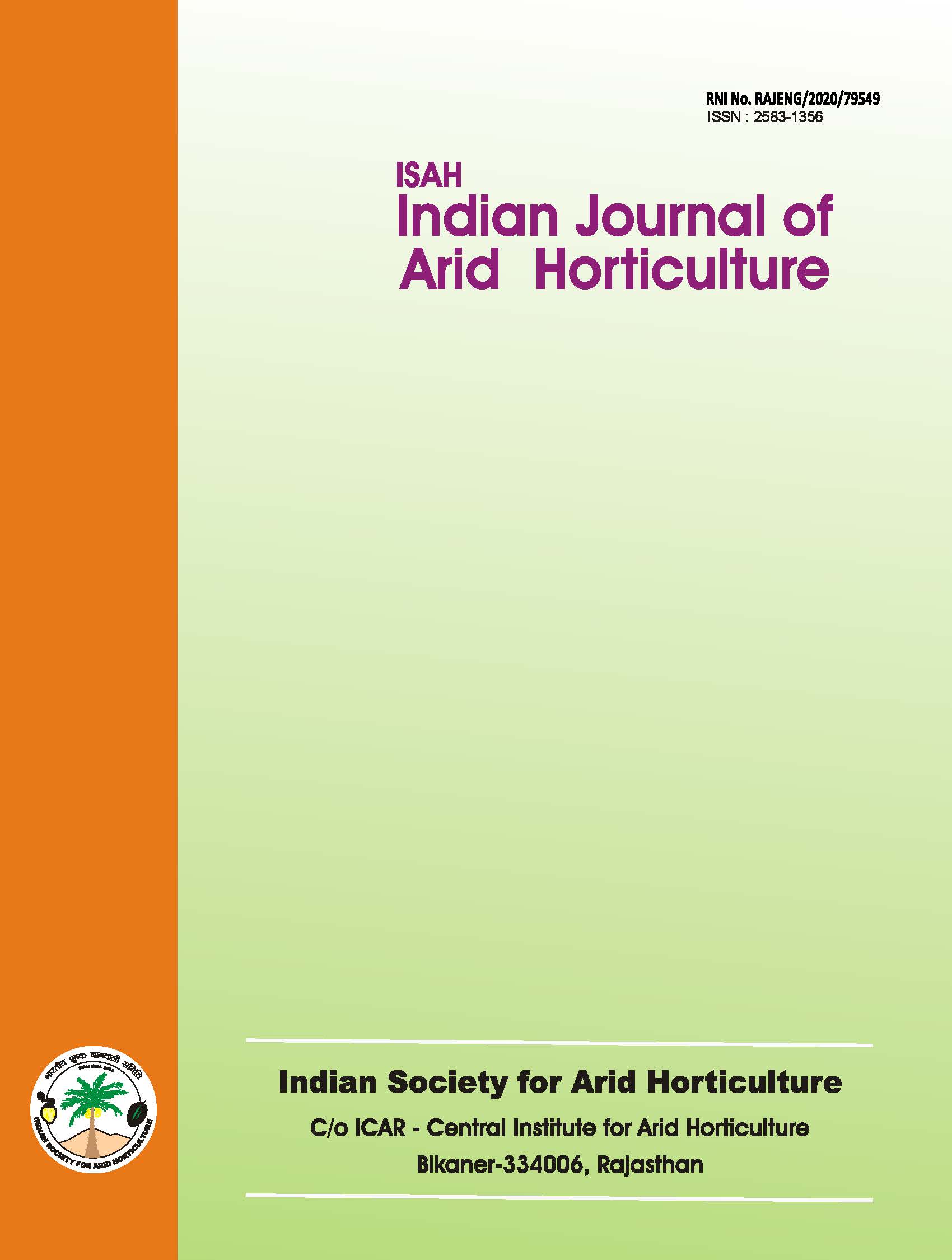Economically important underutilized fruits suitable for arid eco-system: A review
DOI:
https://doi.org/10.48165/ijah.2022.4.1.07Keywords:
Arid eco-system, me dicinal value, underutilized fruit, Minor arid fruitsAbstract
Climatic conditions of the western Rajasthan and some part of Gujarat are characterized by low and erratic rainfall, high thermal oscillation and harsh climatic conditions. Therefore, the land is barren and can be utilized for production of arid fruits which are yet underutilized. Some Fruits like Kair (Capparis deciduas L.), Karonda (Carissa carandas L.), Khejri (Prosopis cineraria), Pilu (Salvadora oleoides), Tamarind (Tamarindus indica), Woodapple (Feronia limonia L.) Swingle), Cactus pear (Opuntia ficus-indica), Dragon fruit (Hylocereus Spp.), Nagphani (Opuntia elatior Mill.), Dansara (Rhus mysorenis Hene ex Wight & Arn.) etc are considered as the underutilized fruits. All these fruit crops are grown naturally and being utilized by local people since long owing to their nutritional values as well as capability to resist the harsh climatic conditions. The fruits crops which are still underexploited and have potential to grow in harsh conditions have been reviewed here. The value addition, post harvest management and future prospects of these crops have also been discussed.
Downloads
References
Anonymous, 1972. The wealth of India-Raw materials (New Delhi, CSIR). 9: 193-195.
Arya, S.S., Toky, O.P., Bisht, R.P. and Tomar, R. 1991. Prosopis cineraria - A promising multipurpose tree for arid lands. Agroforestry Today, 3(4): 13-14.
Bairwa, S.K. 2020. Karonda, Production technology of tropical and subtropical fruit, (eds. P.K. Yadav), New India Publishing Agency, New Delhi. Pp. 343-351.
Corrales, J. and Flores, C.A. 2003. Tendencias actuales y futuras en el procesamiento del nopal y la tuna. In: Nopalitos y tunas,
produccion, comercializacion, poscosecha e industrializacion (Ed. Flores, V.C.A.).1a ed. Universidad Autonoma Chapingo. Mexico, Centro de Investigaciones Economicas, Sociales y Tecnologicas de la Agroindustria y la Agricultura Mundial (CIESTAAM). Pp. 167–215.
Duhan, A., Chauhan, B.M. and Punia, D. 1992. Nutritional value of some nonconventional plant foods of India. Plant Food for Human Nutrition, 42: 193-200.
FAO. 2013. Agro-industrial utilization of cactus pear. Rome. Gupta, N. K., Gupta, Sunita, Jain, S. K. and Sen, N. L. 2001. Plant bioregulators: Potential tools to enhance fruit production in India. In: Seeds, Bioregulants and Applied Plant Biotechnology, Eds. K. K. Bora, K. Singh and A. Kumar, pp 1-22, Pointer Publishers, Jaipur, India
Karunakaran, G., Tripathi, P.C., Singh, P., Arivalagan, M. and Sriram, S. 2020. Smart fruits for 21st century. Souvenir: India Horticulture Summit-2020. 14-16 February 2020, Chitrakoot (M.P.). Pp. 57-69.
Khan, H.A., Meghwal, P.R. and Harsh, L.N. 2004. Salvadora oleoides Decne: An underutilized economic plant of the desert. Science Tech Entrepreneur, 12(12): 61-64.
Kiesling, R. and Metzing, D. 2017. Origin and taxonomy of Opuntia ficus-indica. In book: Crop ecology (eds: Paolo Inglese, Candelario Mondragon, Ali Nefzaoui, Carmen Sáenz.). Cultivation and uses of cactus pear (pp.13-19) Chapter: 02. Publisher: FAO (Food and Agriculture Organization of the United Nations) & ICARDA (International Center for Agricultural Research in Dry Areas).
Kirtikar, K.R. and Basu, B.D. 1999. A textbook of Indian Medicinal Plants. International Book Distributors, Dehradun, India. Edition 3: II, 1173- 8.
Krishna, H., Saroj, P.L., Maheshwari, S.K., Singh, R.S., Meena, R.K.,
Bairwa et al. Economically important underutilized fruits....
Chandra, R. and Parashar, A. 2019. Underutilized fruits of arid & semi-arid regions for nutritional and livelihood security. International Journal of Minor Fruits, Medicinal and Aromatic Plants, 5 (2): 1 -14.
Krishna, H., Singh, R.S., Bhargava, R. and Sharma, B.D. 2016. Genetic diversity in wood apple (Feronia limonia) germplasm collected from Gujarat. India Journal of Arid Horticulture, 11 (1-2): 137-139.
Kumar, K., Singh, D. and Singh, R.S. 2018. Cactus pear: Cultivation and uses. Technical Bulletin No. 73, CIAH, Bikaner. Laura, J.S., Singh, N., Kudesia, R., Kumar, A., Singh, A., Antil, R., Sindhu, P. and Kumar, S. 2014. Study on present status, distribution and factors affecting population of Salvadora oleoides Decne in Haryana. International Journal of Current Research, 6 (12):10855-10857.
Mani, A., Prasanna, V.S.S.V., Praveena, J. and Yadav, A. 2020. Importance, cultivation and value- added products of Tamarind: A wondrous tree legume. International Journal of Agriculture Sciences, 12 (9): 9789-9793.
Meena, V.K. 2015. Ethnobotany of the Pratapgarh Tehsil of Rajasthan, Ph.D. Thesis, University of Kota, Rajasthan. Meghwal, P.R. and Singh, A. 2016. Underutilized Fruits Research in Arid Regions: A Review. Annals of Arid Zone, 56 (1&2): 23- 36.
Meghwal, P.R., Singh, Akath and Singh, A.K. 2019. Maru Gaurav: New Karonda variety. Indian Horticulture, 64 (2&1): 30-31. Mizrahi, Y., Nerda, A. and Sitrit, Y. 2002. New fruits for arid climates. Trends in new crops and new uses. J. Janick and A. Whipkey (eds.) ASHS Press, Alexandria, VA. Pp. 378-384.
Pandey, A.K. 2019 Nutritional and medicinal value of underutilized fruits. Acta Scientific Agriculture, 3(1): 16-22.
Pandy, S., Satpathy, G. and Gupta, R.K. 2014. Evaluation of ntritional, phytochemical, antioxident and antibacterial activity of exotic fruit “Limonia aidissima”. J. Pharmacogn. Phytochem., 3(2): 81-88.
Rawat, S. and Das, K.K. 2020.Value addition of underutilized fruits of arid region: A review. International Journal of Chemical Studies, 8(4): 1655-1659.
Singh, A.K., Singh, S. and Saroj, P. L. 2020. Underutilized fruit crops for nutritional security. Souvenir: India Horticulture Summit-2020. 14-16 February 2020, Chitrakoot (M.P.). Pp. 70-77.
Singh, G.B. and Felker, P. 1995. Edible Cactus - New hope for wasteland development. Wasteland News, 11(2): 58-61. Swathi, H., Shekshavali, T., Kuppast, I.J., Ravi, M.C. and Priyanka, R.A.2015. Review on Rhus mysorensis. The Pharma Innovation Journal, 4(8): 94-96.
Umberto Quattrocchi FLS. 2012. CRC World Dictionary of Medicinal and Poisonous plants. Common names, scientific names, Eponyms, Synonyms and Etymology. Published by CRC Press Taylor & Francis Group, 3211-3212.
Vyas, G.K., Sharma, R., Kumar, V., Sharma, T.B. and Khandelwal, V. 2009. Diversity analysis of Capparis decidua (Forsk.) Edgew using biochemical and molecular parameters. Genetic Resources and Crop Evolution, 56: 905-911.
Yadav, V. 2018. Wood apple keeps tribals healthy and wealthy. Indian Horticulture, 63 (5): 74-77.

